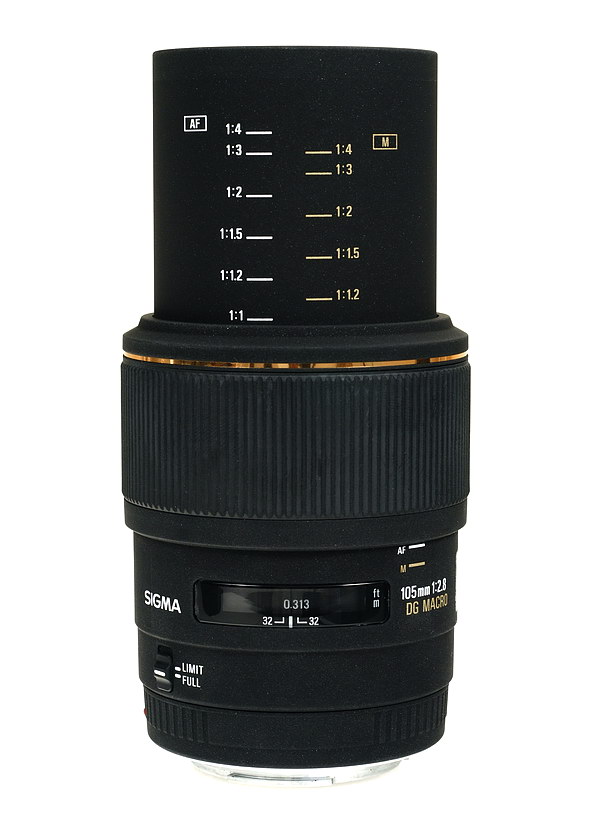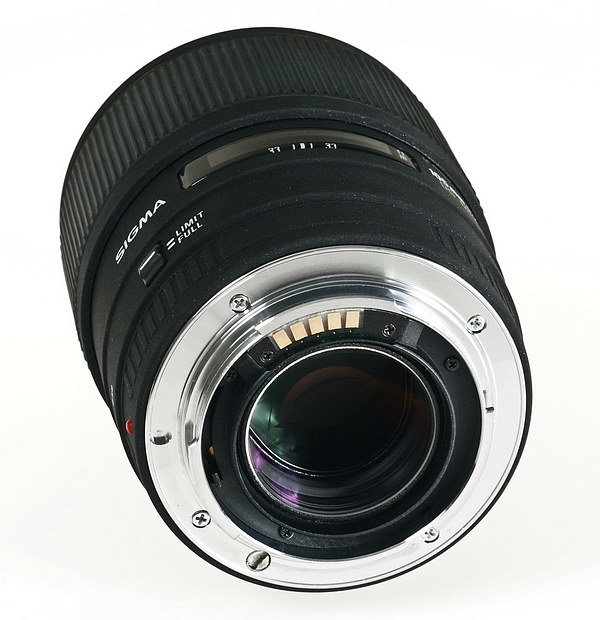|
Lens
|
Sigma 105mm DG F/2.8 macro
|
|
Box contents
|
Front and rear caps, hood, nice soft case and users manual.
|
|
Cost
|
$379 street pricing. No longer available in 2012.
|
|
Build quality
|
Good, but has a laughable dirt-like finish.
|
|
Additional information
|
Has focus limiter switch. Shorter working distance than the Sony 100mm F/2.8 macro.
|
| Specifications below |
|
|
Optical configuration
|
11 elements in 10 groups
|
|
Angle of view
|
23.3° (full frame) 15.5° (APS-C)
|
|
Aperture
|
8 blades, straight
|
|
Full frame and APS-C
|
Yes, made for full frame. APS-C equivalent, 157.5mm
|
|
Depth of field and focus scales?
|
Yes and yes
|
|
Minimum focus, image plane to subject
|
12.2″ (310mm)
|
|
Minimum focus, end of lens barrel to subject
|
4.7″ (119mm)
|
|
Hard stop at infinity focus?
|
Yes
|
|
Length changes when focusing?
|
Yes
|
|
Focus ring turns in AF?
|
Not in AF mode, but will in MF without switching off AF
|
|
Filter size
|
58mm
|
|
Filter ring rotates?
|
No
|
|
Distance encoder?
|
No
|
|
Max magnification
|
1:1
|
|
Min. F/stop
|
F/45
|
|
Sony teleconverter compatible?
|
No
|
|
Dimensions W x L (my measurements)
|
2.9″ x 3.8″ 75mm x 97mm
|
|
Maximum extended length (my measurements)
|
5.8″ (148mm)
|
|
Weight bare (my scale)
|
15.8oz (449g) 16.6oz (471g) with caps
|
Requisite product shots.
 |
| Box and contents. |
 |
| Fully extended. |
 |
| Deep front element, notice dirt look finish on lens. |
 |
| Backside. |
 |
| Sigma MTF screen grab, incomplete, but this is all they give. |
 |
| X-ray view |
The Sigma 105mm F/2.8 DG macro lens (made in Japan) is very compact, but extends out another 2″ at full macro. Its build quality is ok to good, but lots of plastic. The finish is atrocious flat speckle black which looks like dirt all over the lens, I hate the look of this lens and the finish, it’s the ugliest mess I’ve ever seen. Are you reading Sigma? Filter size is 58mm. The lens is multi-coated, with a very bright green look. It has an 8 blade (straight) aperture as opposed to the circular 7 and 9 blades of the Sony macro lenses.
The lens has the focus distance window with standard markings for FT/M, and DOF marks at F/32. It has magnification levels from 1:1 to 1:4 written on the extended lens barrel. The magnification marks are different for AF and MF because of the sliding focus ring, which is also used to switch between MF and AF, back for manual, forward for auto focus. This is weird as the focus ring will still turn when slid back to manual focus, you need to switch the camera to manual focus to stop it from turning. The owners manual says you might screw up the focus motor in the camera if you don’t do this. Another useful item is a focus limiter switch, full, for the full focusing range, and two limited ranges, close, which cuts the focus travel down to approximately 4.7″- 7.5″ (190mm-178mm) and about 8.5″ (216) to infinity at far range. To set you just throw the switch while in the range you want. This helps speed up focusing, but don’t use auto-focus for extreme close ups, use manual to get the subject in focus and then move the camera back and forth until your target is sharp. The figures above are for end of lens barrel to subject distances.
Lens flare/ghosting. Not much of a problem here. Look for a green blob when the sun is out of center, and still in the image, with the sun centered, everything looks fine. Additionally, the lens has plenty of recess for the front element from close focusing to infinity. You don’t need to use the included metal hood with this lens unless super bright lights are near the camera front. See samples below.
|
Sun in shot, F/5.6
|
Sun centered, F/5.6
|
 |
 |
|
Bokeh, F/2.8
|
Bokeh, F/4
|
 |
 |
 |
| Minor pincushion distortion. |
Light fall-off, (directly below) is very light at F/2.8, and clears up at F/4 focused at infinity. At high magnifications (close) it effectively stops down, (see chart below) so no problems at all.
|
F/2.8 focused at infinity
|
F/5.5 close focused at 1:1
|
 |
 |
Here are the approximate F-numbers you will get as you increase the magnification per owners manual. These numbers will not be indicated on the camera, and will still read F/2.8 even at 1:1 magnification, but look at your shutter speeds and you’ll notice the loss. I provide this information to those who wonder why they’re getting low shutter speeds at F/2.8 when using high magnification. Don’t worry, your camera will adjust the exposure correctly for you, just shoot away.
|
Magnification
|
F-number
|
|
1:40
|
2.8
|
| 1:4 | 3.6 |
| 1:3 | 3.8 |
| 1:2 | 4.2 |
| 1:1.5 | 4.7 |
| 1:1.2 | 5.1 |
| 1:1 | 5.5 |
 |
| This is the full shot, below are the center crops. |
|
F/2.8
|
 |
|
F/4
|
 |
|
F/5.6
|
 |
|
F/8
|
 |
|
F/11
|
 |
| F/16 |  |
Macro shot.
The macro shot is very sharp, and without color fringing. The sharpest shots come at F/8. This lens is the best for macro imaging, better even than the Sony and Nikon macros tested here.
|
Full frame results using the Sony A900 below.
Check out the differences when using a film or full frame camera below. I’m only pointing out the noticeable issues as compared to the APS-C bodies, so if I don’t show it here, the results are not significantly different enough to warrant posting an additional set of images in this section.
Light fall-off
Light fall-off is moderate at F/2.8 with full frame coverage, and focused at infinity. At F/4 it’s nearly gone. Good job here.
Full image from A900 below.

The dark corners are not noticeable in this F/2.8 1/2500s, ISO 200 shot.
Center samples next.
The center crops in the APS-C section look bad between F/2.8-5.6. They were taken at infinity focus, with the subject about 300 meters away. The crops directly above were taken at infinity focus with the subject about 100 meters away. The difference is astounding! There’s more than likely a problem with focus calibration, but I’m not going to turn it in like I normally do with Sigma lenses because I really like the way the lens is sharp at F/2.8 from corner to corner, with almost non-existent color fringing. I don’t use this lens for far away subjects. If I turn it in for repair, Sigma may fix the focus problem, only to cause another issue somewhere else in the chain. If you buy a copy of this lens, it may perform differently from this one.
Corner samples below.
The corners look almost as good at F/2.8 as the center crop does at F/8! That’s why I included it in the lower right. As you can see, there isn’t any reason to stop down to sharpen up the corners. The corners are sharper on this lens than on the Sony macro lenses. The exposure differences are from light fall-off.
Distortion.
This lens produces some pincushion distortion, and looks almost the same as the APS-C image shows.
|
Conclusion.
This copy of the Sigma 105mm F/2.8 DG macro lens may have some issues with long distance focusing, judging by the results above. This is a macro lens and if you’re going to use it as a macro lens, you don’t need to worry about the infinity focus shots. Knowing Sigma, your copy may produce different results(!). This lens also has nearly no perceptible color fringing or light fall-off, that’s real good. Also, in macro range, it’s very sharp from F/5.6-11, and will hold its own against other macros far more expensive. I use this lens for product shots because of the sharpness and lack of color fringing. If you like to take pictures of artwork, currency or jewelry etc, look no further. This is a $350-$380 lens and is a steal for macro imaging.
Full frame results are basically the same as the APS-C coverage, which is great. This lens is better all the way around than the Sony 100mm F/2.8 macro, except for the focusing issue, there always has to be a downer right?
Check out the newest version of this lens here.









